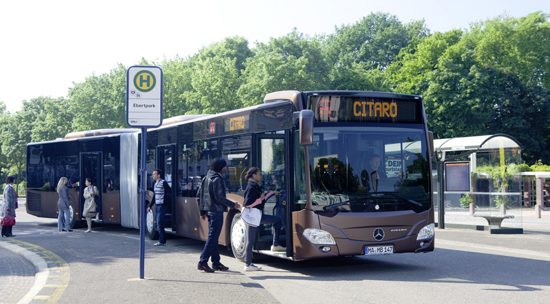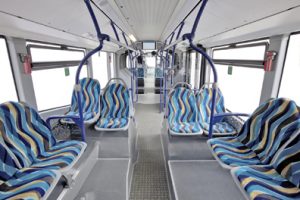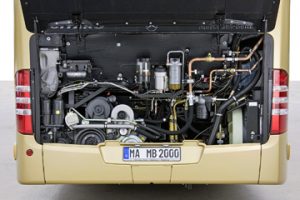
By Doug Jack


Having built nearly 35,000 versions of its popular Citaro city bus range since 1998, Mercedes-Benz raised the bar with its launch of the new generation Citaro in May from Mannheim, Germany.
Before I go any further, let me clear up possible confusion about brands. The parent company is Daimler AG, of which one of the subsidiaries is Daimler Buses. Some senior executives in that organization have global responsibilities that include Orion in North America, the Polomex joint venture in Mexico, and a very large chassis manufacturing operation in Brazil.
The wholly-owned subsidiary, EvoBus GmbH, EvoBus, with factories in France, Germany, Spain and Turkey, sells Mercedes-Benz city buses and Setra luxury coaches.
Beginning January 2014, the new and more stringent Euro 6 emission limits will be standard, a factor that helped persuade Mercedes-Benz to develop the new Citaro.

“The general view is this will take a combination of EGR and SCR,” says Hartmut Schick, head of Daimler Buses. “We will need a chemical factory at the back of every bus.”
Schick says the company wanted to include safety and weight-saving features as well.
The Citaro launched with two models and has evolved into a wide range of models needing replacement as Euro 6 takes effect.
Andreas Renschler, a member of the Daimler AG Board of Management and responsible for Commercial Vehicles, hosted the launch in the historic plant in Mannheim where Carl Benz built the first bus in 1895. Renschler described it as the unofficial capital of bus production. He says the world needs the bus because it is unbeatable in at least three ways. First, no other form of transport comes close to the bus in terms of safety. Second, buses out-perform other forms of transport in terms of eco-friendliness. The CO2 emissions of a modern coach are a third lower than the equivalent figure for trains. Thirdly, buses are incredibly flexible. They do not need tracks or stations and they had unbeatable whole life cycle costs.
He predicted growth in the bus business because more and more people are moving to urban centers. In just 20 years, around 60 percent of the global population will live in towns and cities. Buses already have a 46 percent share of the market, making them the backbone of public transport.
Renschler says Mercedes-Benz buses are universally reliable, as the company sets global benchmarks for new technologies.

“Our buses lead in terms of active and passive safety,” he says. “No other manufacturer has more vehicles on the road with alternative drive systems, including nearly 3,200 hybrid buses from Orion and Mercedes-Benz, and the totally emission-free Citaro FuelCELL hybrid buses.”
He described the new Citaro as a design that will grace any city street, a cab that drivers will never want to leave, and an unparalleled safety package.
While the new Citaro looks similar to the current model, it shows many innovations. The structure still built of mild steel are fully immersed in chemicals that resistance corrosion.
Although not a legal requirement on European city buses, the structure meets the new and more stringent rollover legislation for coaches, which will come into force in 2014. Though the gross vehicle is 200 pounds lighter, it will increase 60 pounds with the installation of the Euro 6 engines.
The driver sits at a lower level in the current Citaro, which is not ideal for eye-to-eye contact with standing passengers. On the new Citaro the raised platform in his compartment provides space for batteries underneath, which at the same time improves weight distribution. The strengthened frame beneath the driver gives him protection in the event of a frontal collision.
The new Citaro has independent front suspension to enhance ride and handling, as well as Electronic Braking System and the option of Electronic Stability Program. The latter will become mandatory on coaches, but Mercedes-Benz also believes it could be beneficial on city buses, especially on snow and ice.
The new Citaro will not replace the current generation overnight. There are nearly 30 variations of the family, with low entry and full low floor layouts, 34-, 40-, 45- and 60-foot articulated. The four axle Capacity is performing well in Istanbul. Options include diesel, CNG, hybrid and fuel cell hybrid, not to mention left and right hand drive.
Transit authorities are already placing orders for the new Citaro with deliveries to commence in September. The two ranges will continue in parallel production to accommodate orders and tenders for the current Citaro family as well. The changeover is likely to take two years, leading up to the introduction of Euro 6.
The 40- and 60-foot articulated pre-production models were available for demonstration drives. Some of the local road surfaces were quite rough, but I travelled on the 40-foot model and was most impressed by the ride and comfort. The interior trim was practical and easy to clean, formed in ABS to car quality standards. Care had been taken to use light but strong materials to save weight. There were plenty of handrails for standing passengers. A person in a wheelchair could get on and off the bus by a ramp at the second door. The doors operate electrically, saving weight and maintenance.
The timing of the launch of the new Citaro looks good. Renschler says the current market environment in some European countries is difficult.
“However, we have been in the business for more than 100 years,” he says. “We always look beyond economic cycles.”
He predicted that the bus business would pick up from the middle of this year, and that Daimler would sell more than 40,000 buses and chassis this year (excluding North American school buses).
Planning is difficult in the large domestic German market. Public authorities normally go to tender at the beginning of the calendar year, pressuring delivery on orders before the end of the year; which means output in Mannheim is traditionally lower during the first half of the year.
Mercedes-Benz has responded to the cyclical nature of the business in a very clever way. It reached agreement with the workforce to pay a standard weekly rate. Normally, they work fewer hours than the standard rate in the first half of the year. The company can now bank those hours to use during the second half of the year, when the workload requires extra hours. This suits the workers because they have a regular weekly income, and it suits the company because it can respond when customers want delivery on tight lead times.
The narrower European maximum width of 98.5-inch makes the new Citaro is unsuitable for North American markets. However, Orion has access to Daimler’s global bus design and production technology, so some of the innovations might filter through to your market in due course.
The first major public unveiling of the new Citaro will likely take place at Busworld Kortrijk later this year, where other European manufacturers also will introduce new products. So why not come across the pond to Belgium and see what we are doing in Europe?
Doug Jack is with Transport Resources in the United Kingdom.
